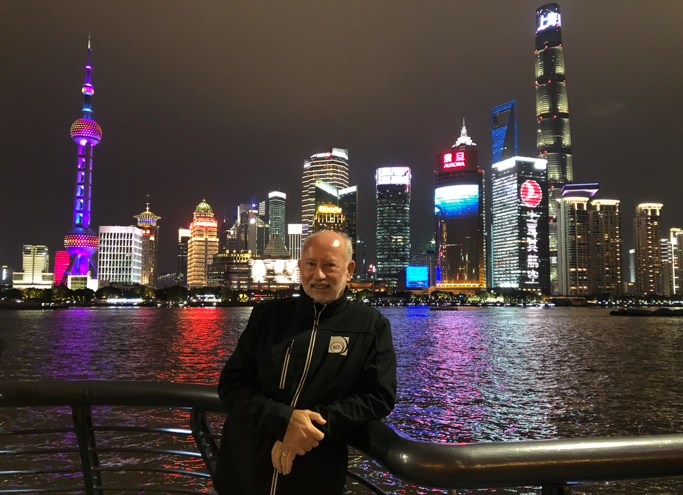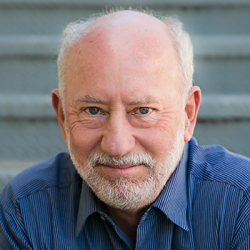
Since PBL is not yet on the trade war list (insert winking emoji), three weeks ago I traveled to Shanghai on my first-ever trip to China. I had been invited by the Shanghai Academy of Educational Sciences to deliver a keynote at a PBL conference called “Envisioning Learning.” I also led a two-hour workshop for teachers at a school.
I knew there was growing interest in PBL in China because of the number of recent inquiries we’ve been getting about translating and publishing our books there. We now have a contract with Guangming Daily Press to publish PBL Starter Kit, PBL in the Elementary Grades, and PBL for 21st Century Success. ASCD also has a contract with them to publish Setting the Standard for Project Based Learning, and is talking with them and others about our latest book, Project Based Teaching.
The Buck Institute did a PBL 101 workshop for teachers in Shanghai last June, conducted by our National Faculty member Andrew Miller, who works at the Shanghai American School. The 101 was arranged by Tammy Shen, director of Sanyou PBL, a small nonprofit with Buck-like aspirations for being a leader for PBL in China. They’ve got a great slogan – see coffee cup & totebag below – and have already distributed 10,000 free copies of a booklet called Hello PBL! composed of articles and blogs from the Buck Institute website.
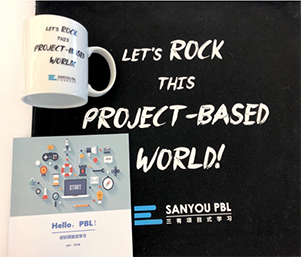
My Keynote at the Conference
My presentation was an overview of our Gold Standard PBL model, along with our drumbeat message for “main course, not dessert” projects. My keynote was followed by 10 other speakers. Most were Chinese, along with a team from England who talked about the “Science Art Writing” (SAW) program – which sounds great, check it out – and a professor from Finland, Sirpa Eskela-Haapanen, who explained their approach to “phenomenon-based learning.” The only other American speaker was Ray Pecheone, director of the Stanford Center for Assessment, Learning, and Equity (SCALE). His colleague Pai-rou Chen also made a presentation about their excellent performance tasks (which btw teachers can download for free).
My presentation was well received, although I noted some things about the culture in China which has implications for how well PBL will be received. I did the usual Buck-style professional development: interactive (the speakers who followed me all gave lectures, which is the norm in China). I showed a video of a kindergarten project and then asked the 450 members of my audience to “turn and talk” to each other about it. Silence. Well, not quite total silence – maybe 10% of the attendees started talking. As I left the podium and walked down the aisle (which was also a norm-breaking move) to encourage them and see if there were any questions, I asked one of my hosts about it. She said, “They don’t know each other” – unlike gabby Americans who will turn and talk with a stranger. So when we think about the possibility of PBL workshops for teachers in China, we will need to take this into account.
Another cultural characteristic in China may present a more fundamental challenge for PBL itself. One of our Essential Project Design Elements is “student voice and choice,” aka student agency. In China, I wonder what this might mean for parents and educators who want students to follow the rules and listen quietly as teachers transmit knowledge. PBL would be a big shift. This is true to some extent even in the U.S., of course. Another barrier to PBL in China is the all-important test students take at the end of high school, their gateway to college and careers. Accordingly, most of the attendees at the conference were from elementary schools, because PBL is seen as more possible there, before the test-prep starts in secondary school. This situation, like the testing pressure teachers face in the U.S., will be slow to change, I fear.
My Workshop at a School
I had a very different experience facilitating a PBL workshop at Shanghai United International School. The teachers knew each other and dug right into the interactive work. They already had experience with PBL, I soon realized (and saw on my tour of the school when students were there two days later), and came up with some good ideas for projects—here is one of their gallery walk posters:
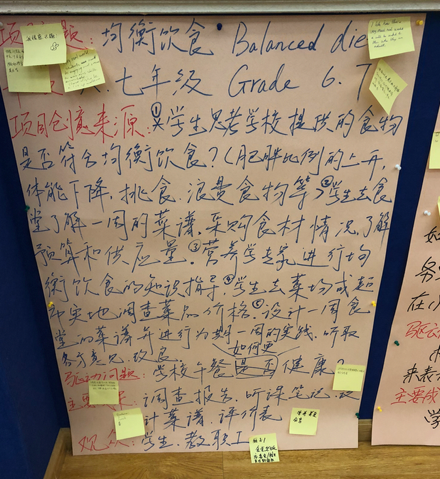
This is a private school with a bilingual program; most lessons are conducted in English. I was impressed with the leaders, teachers, and students. They’re doing some great PBL units already, like the 2nd graders below.

Being a private school is significant; that’s where most of the PBL is happening so far in China. Like in the U.S., the regular public school system is slower to adopt innovations. There are some special magnet schools, like charters in the U.S., that are using PBL. My Stanford colleagues toured He Tian Road Elementary School, which for three years has been using PBL successfully for math, and liked what they saw. Ray Pecheone said, "The teachers appeared highly knowledgeable and demonstrated a high command of PBL pedagogical principles. Most impressive in my visit was the exercise of student voice and agency -- I observed students leading discussion, presenting their work and discussing counter examples or approaches to the solution of the problem." Pai-rou Chen noted, "It also felt like the PBL way of thinking and doing things has been gradually spreading out (beyond math) and becoming the culture of the school."
Another thing Shanghai United School does well is its focus on a set of 9 core values (international mindedness, thoughtfulness, adaptability, morality, cooperation, respect, enquiry, resilience, communication) which students reflect on regularly, including writing in a booklet with prompts the school provides. Another useful tool for PBL that I hadn't seen before was an “Inquiry Project Workbook” given to students for each major project, where they set personal goals, reflect on their learning, and ask questions. Here’s one page:
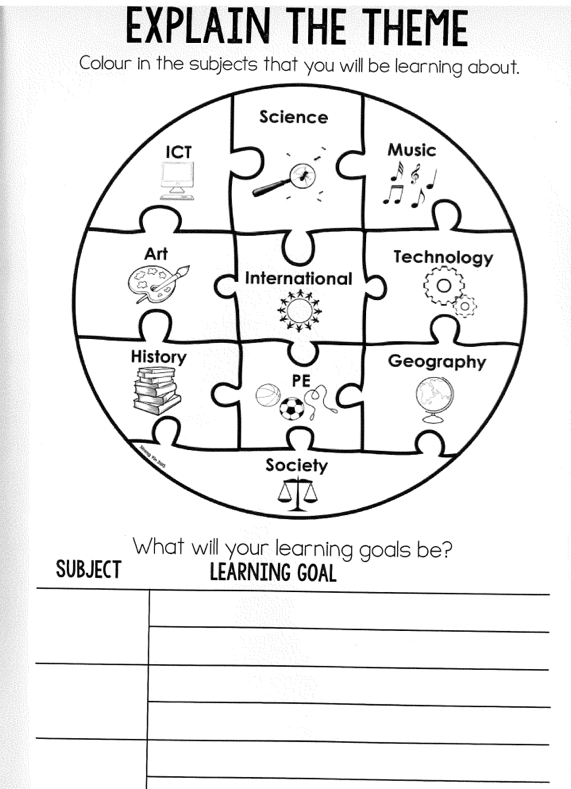
The Future of PBL in China
I came away from my six-day trip with two competing feelings (which are admittedly based on superficial evidence). I was impressed not only with the interest in PBL but also by the fact that it’s already happening in some pockets of the education system, like the schools we visited. But I wonder how long it will take to see widespread adoption of PBL across the vast number of classrooms in China, and whether the projects students do will match my vision of “gold standard” PBL. Both of these feelings mirror what I feel about schools in the U.S. and everywhere else PBL is spreading—which tells me that educators all around the world really are in the same boat!
